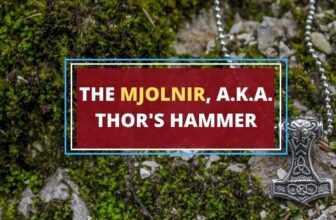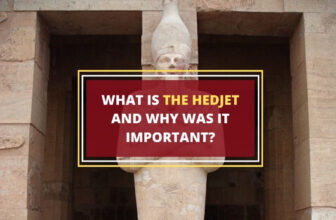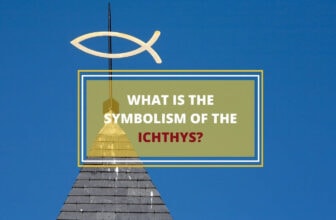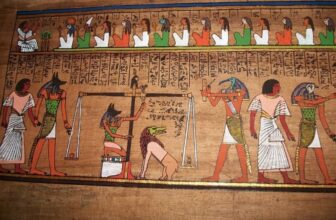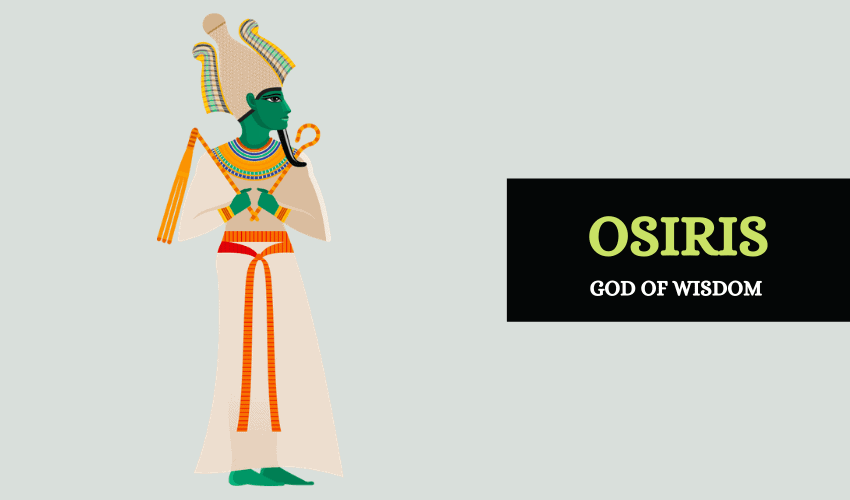
Table of Contents
In Egyptian mythology, Osiris was the god of fertility, life, agriculture, death and resurrection. Osiris’ name meant powerful or mighty, and according to tradition he was supposed to be Egypt’s first pharaoh and king.
Osiris was represented by the mythical Bennu bird, which had the power to resurrect itself from ashes. His myth was incorporated into various literary genres and became the most popular and well-known tale in all of Egypt.
Let’s take a closer look at the myth of Osiris and examine its significance in Egyptian culture.
Origins of Osiris
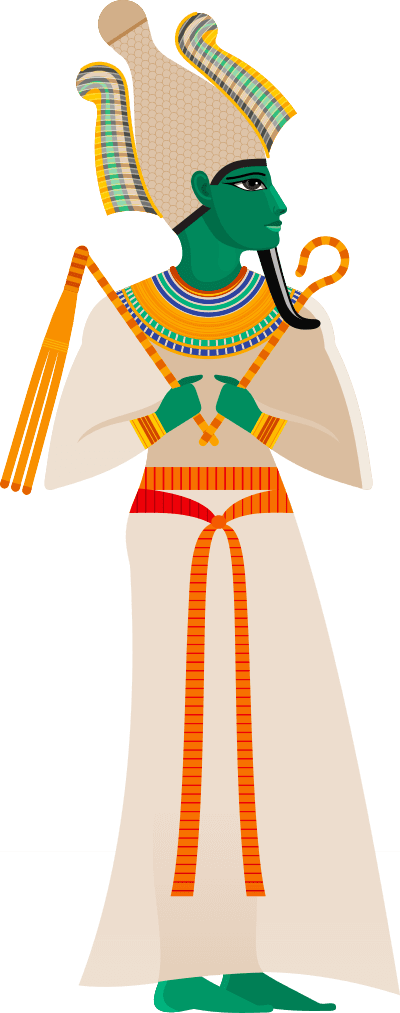
Osiris was born to creator gods Geb and Nut. He was the first king to govern and rule the people of Egypt, and for this reason he was called Lord of the Earth. Osiris reigned with Isis, who was his queen and companion.
Historians deduce that Osiris existed as a pre-dynastic deity, as either the ruler of the Underworld, or a god of fertility and growth. These pre-existing stories and tales were amalgamated into one coherent text, called the myth of Osiris. Some historians hypothesize that the myth could also be a reflection of a regional conflict in Egypt.
The myth of Osiris took on an entirely new form when the Greeks colonized Egypt. The Greeks adapted the myth into their own context and merged the story of Osiris with that of the bull god, Apis. As a result, a syncretic deity was born under the name of Serapis. During the reign of Ptolemy I, Serapis became the chief God and patron of Alexandria.
Below is a list of the editor’s top picks featuring the statue of Osiris.
Characteristics of Osiris
In Egyptian art and paintings, Osiris was depicted as a handsome man with black or green skin. The green skin was to represent his deceased status, as well as his association with rebirth.
Osiris wore the Atef or crown of Upper Egypt on his head and carried a crook and flail in his arms. In some pictures, Osiris was also portrayed as a mythical ram, known as Banebdjed.
Images on tombs and burial chambers, showed Osiris as a partly mummified being, signifying his role in the Underworld.
Symbols of Osiris
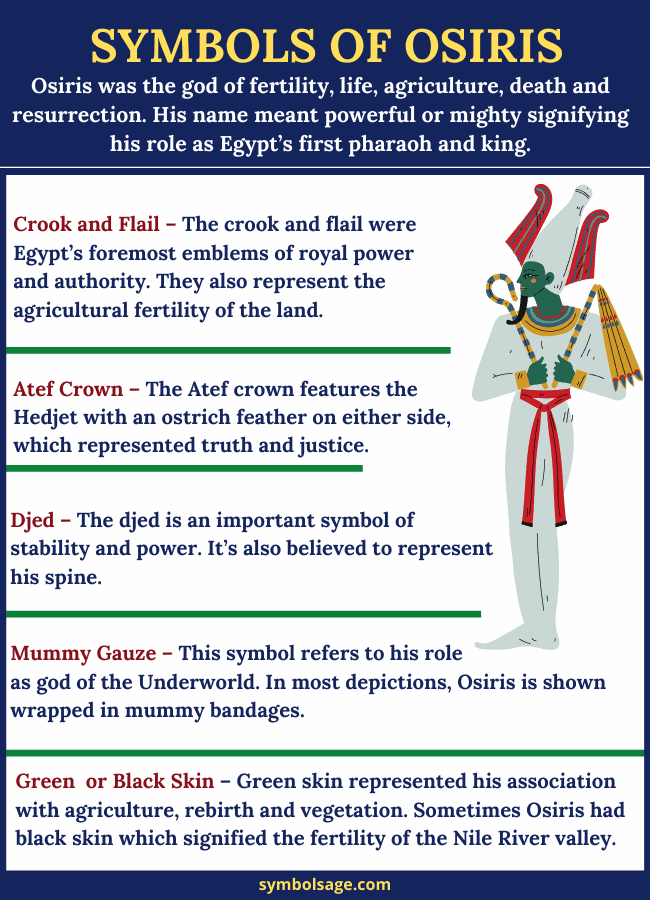
There are several symbols used to represent Osiris. Here are some of the most common symbols of Osiris:
- Crook and Flail – The crook and flail were Egypt’s foremost emblems of royal power and authority. They also represent the agricultural fertility of the land.
- Atef Crown – The Atef crown features the Hedjet with an ostrich feather on either side.
- Djed – The djed is an important symbol of stability and power. It’s also believed to represent his spine.
- Ostrich Feathers – In ancient Egypt, feathers represented truth and justice, much like the single feather of Ma’at. Incorporating ostrich feathers into Osiris’ crown symbolized his role as a just and truthful ruler.
- Mummy Gauze – This symbol refers to his role as god of the Underworld. In most depictions, Osiris is shown wrapped in mummy bandages.
- Green Skin – The green skin of Osiris represented his association with agriculture, rebirth and vegetation.
- Black Skin – Sometimes Osiris was depicted with black skin which signified the fertility of the Nile River valley.
Myth of Osiris and Set
Despite the fact that the myth of Osiris was the most coherent of all Egyptian tales, there were several variations to the story. Some of the most prominent and popular versions of the Osiris myth will be explored below.
- Osiris and His Sister, Isis
Osiris was the first king of Egypt who successfully introduced civilization and agriculture into the provinces. After Osiris fulfilled his basic duties, he went on a world-tour with his sister and consort, Isis.
After a few months, when the brother and sister returned to their kingdom, they were met by a fierce challenge. Osiris’ brother Set was ready to usurp the throne, and their return hindered his plans. To prevent Osiris from ascending the throne, Set slew him and mutilated his body.
After this gruesome event, Isis and Horus decided to avenge the dead king. Isis and her son managed to defeat Set. Isis then collected all of Osiris’ body parts and buried Osiris’ body, but she kept aside his phallus, made replicas of it, and distributed them across Egypt. The replicas became important locations of shrines and centers of worship all over the Egyptian kingdom.
- Osiris and His Affair with Nephthys
Osiris, the king of Egypt was a remarkable ruler and king. His brother Set, was always jealous of his powers and abilities. Set became even more envious when his consort, Nephthys, fell in love with Osiris. An enraged Set couldn’t contain his anger, and murdered Osiris by attacking him in the form of a beast. Some other accounts claim that it was by drowning him in the Nile River.
Set, however, didn’t stop at murder, and he further dismembered Osiris’ body, to assure himself of the kings’ demise. He then scattered every piece of the god’s body in different places of the country.
Isis gathered all of Osiris’ body parts and put together the body of Osiris, with the help of Nephythys. She then was able to resurrect him long enough to have intercourse with him. Isis then gave birth to Horus, who became the rival of Set, and the rightful heir to the throne.
- Osiris and Byblos
In another version of the Osiris myth, Set murdered Osiris by tricking him into a coffin, and pushing him into the Nile river. The coffin floated to the land of Byblos and continued to remain there. The king of Byblos came across the coffin during one of his travels. However, he couldn’t recognize it as a coffin since a tree had grown around the wood. The king of Byblos took the tree back to his kingdom, and his carpenters carved it into a pillar.
The pillar, along with Osiris’ hidden coffin, remained in the palace of Byblos, until the arrival of Isis. When Isis reached Byblos, she appealed to the king and queen to extract the coffin from the pillar and get back her husband’s body. Though the king and queen complied, Set came to know of this plan and obtained Osiris’ body. Set cut up the body into several pieces, but Isis was able to put it back, and impregnate herself with Osiris phallus.
Although there are several versions of the myth of Osiris, the basic elements of the plot remain the same. Set murders his brother and usurps the throne, Isis then avenges Osiris’ death by giving birth to Horus, who then challenges Set and reclaims the throne.
Symbolic Meanings of The Myth of Osiris
- The myth of Osiris symbolizes the battle between order and disorder. The myth conveys the idea of Ma’at, or the natural order of the world. This balance is constantly disrupted by unlawful acts, such as Set usurping the throne, and the murder of Osiris. However, the myth conveys the idea that evil can never reign for long, and Maat will eventually be restored.
- The myth of Osiris has also been used as a symbol of the cyclic process of birth, death and afterlife. Osiris, as the god of afterlife, has come to symbolize rebirth and resurrection. Due to this, many Egyptian kings have identified themselves with the Osiris myth, in order to ensure reincarnation through their descendants. The myth has also reiterated the importance of being a virtuous, benevolent and noble king.
- For the Egyptians, the myth of Osiris was also an important symbol of life and fertility. The flood waters of the Nile River were associated with the bodily fluids of Osiris. The people assumed that the flood was a blessing from Osiris and enabled a rich growth of plant and animal life.
Festivals Celebrated in Honor of Osiris
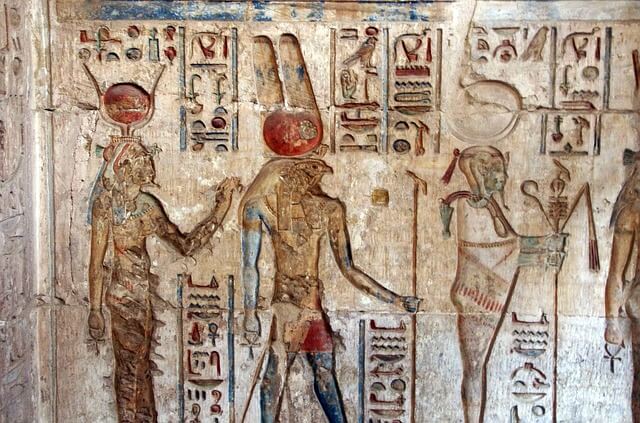
Several Egyptian festivals such as The Fall of the Nile and the Djed Pillar Festival celebrated the return and resurrection of Osiris. One of the most important rituals in these festivals, was the planting of seeds and crops. Men and women would dig up several beds of soil and fill it with seeds. The growth and germination of these seeds symbolized the return of Osiris.
In these festivals, long dramas were enacted and performed based on the myth of Osiris. These dramas would usually end with the rebirth and resurrection of the king. Some people would also make a model of Osiris, using temple grown wheat and water, to signify his rise from the dead.
Ancient texts on the myth of Osiris
The myth of Osiris first appears in the Pyramid Texts during the Old Kingdom. But the most complete account of the myth only appeared several years later, in the Great Hymn to Osiris. The myth was also reimagined in a humorous way in The Contending’s of Horus and Set, written during the Twentieth Dynasty.
However, it was the Ancient Greek and Roman writers who compiled the myth into a coherent whole and formulated a complete account of the details. Therefore, much of what’s known today comes from the various insights of ancient Greek and Roman writers.
Myth of Osiris In Popular Culture
Osiris appears as a god of death and afterlife in popular movies, games and television series. In the film Gods of Egypt, Osiris appears as a king of Egypt, and gets murdered by his brother Set. His lineage continues with the birth of his son Horus.
Osiris also features in the television series Supernatural. In season seven, he emerges as the god of the Underworld, and passes judgement on Dean’s merits and demerits.
In the popular game, Age of Mythology, Osiris appears as a god, and helps the players by providing them with an extra pharaoh. The players are also asked to reunite Osiris’ body parts and oppose Set.
In Brief
The myth of Osiris continues to be one of the most popular and influential Egyptian myths due to its relatable story, theme and plot. It has inspired writers, artists, and even new religious movements.







